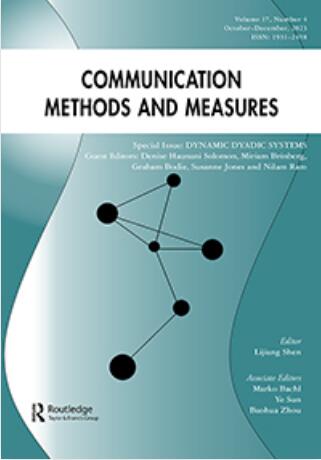传播学术中潜在变量混合模型的系统文献综述
IF 3.7
1区 文学
Q1 COMMUNICATION
引用次数: 0
摘要
摘要近年来,潜在变量混合建模因其在更广泛人群中发现未知群体的独特能力而在许多学科中受到关注。事实上,这种方法假设人群中存在有限数量的混合物(即未知群体),并且可以通过评估参与者对一组明显指标的反应模式来发现。尽管采用了直观的方法,但已经提出了一些建议,以克服与潜在变量混合建模相关的一些方法问题。本研究的主要目的是了解传播研究中潜在变量混合建模的特点,并评估现有研究满足这些建议的程度。对2010年至2022年间在18种传播期刊上发表的95篇手稿进行了鉴定和系统分析。综述发现:(1)潜在变量混合建模的使用有所增加;(2) 潜类分析和潜剖面分析是最常见的模型;以及(3)大多数手稿不符合随机起始值、辅助变量程序、指标要求和缺失数据程序的规定标准。与被禁止的标准相比,这些发现得到了更多的讨论。此外,还提供了概念性和适用性建议,以提高传播学术水平。本文章由计算机程序翻译,如有差异,请以英文原文为准。
A Systematic Literature Review of Latent Variable Mixture Modeling in Communication Scholarship
ABSTRACT Recently, latent variable mixture modeling has gained traction in many disciplines, given its unique ability to discover unknown groups within a broader population. Indeed, this method assumes that a finite number of mixtures (i.e. unknown groups) exist within the population and can be discovered by evaluating participants’ response patterns to a set of manifest indicators. Despite the intuitive approach, recommendations have been proposed to overcome some methodological concerns associated with latent variable mixture modeling. The primary purpose of this study was to understand the characteristics of latent variable mixture modeling in communication research and to evaluate the extent to which the existing research meets these recommendations. Ninety-five manuscripts published between 2010 and 2022 in 18 communication journals were identified and systematically analyzed. The review found that (1) the use of latent variable mixture modeling has increased; (2) latent class analysis and latent profile analysis are the most common models; and (3) most manuscripts did not meet the proscribed standards for random start values, auxiliary variable procedures, indicator requirements, and missing data procedures. These findings are discussed more in comparison with the proscribed standards. In addition, conceptual and applicable recommendations are provided to improve communication scholarship.
求助全文
通过发布文献求助,成功后即可免费获取论文全文。
去求助
来源期刊

Communication Methods and Measures
COMMUNICATION-
CiteScore
21.10
自引率
1.80%
发文量
9
期刊介绍:
Communication Methods and Measures aims to achieve several goals in the field of communication research. Firstly, it aims to bring attention to and showcase developments in both qualitative and quantitative research methodologies to communication scholars. This journal serves as a platform for researchers across the field to discuss and disseminate methodological tools and approaches.
Additionally, Communication Methods and Measures seeks to improve research design and analysis practices by offering suggestions for improvement. It aims to introduce new methods of measurement that are valuable to communication scientists or enhance existing methods. The journal encourages submissions that focus on methods for enhancing research design and theory testing, employing both quantitative and qualitative approaches.
Furthermore, the journal is open to articles devoted to exploring the epistemological aspects relevant to communication research methodologies. It welcomes well-written manuscripts that demonstrate the use of methods and articles that highlight the advantages of lesser-known or newer methods over those traditionally used in communication.
In summary, Communication Methods and Measures strives to advance the field of communication research by showcasing and discussing innovative methodologies, improving research practices, and introducing new measurement methods.
 求助内容:
求助内容: 应助结果提醒方式:
应助结果提醒方式:


